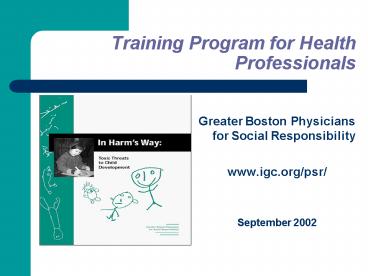Training Program for Health Professionals PowerPoint PPT Presentation
1 / 26
Title: Training Program for Health Professionals
1
Training Program for Health Professionals
- Greater Boston Physicians for Social
Responsibility - www.igc.org/psr/
- September 2002
2
PROGRAM OUTLINE
- Section I. Neurodevelopmental
Disabilities - Section II. Links Between Chemicals
and Disabilities - Section III. Magnitude of the Chemical
Threat
3
Section I. Outline Neurodevelopmental
Disabilities
- Clinical/Public Health Dimensions
- The Research/Evidence Problem
- Conceptual Framework
- Clinical Traits Syndromes
- Underlying Cellular Biology
4
Prevalence of Learning and Behavioral
Disabilities
Public Health Dimensions
- Total 17, 12 million children
- Learning disabilities 5-10
- ADHD 3-5
- Autism 0.05
5
Reported Trends Real? Better reporting?
Changing criteria?
Public Health Dimensions
- Learning disabilities
- 191 Children in special education
- 1977-1994
- ADHD
- 1 20 Reported prevalence
- 800 Ritalin use
- since 1971
6
Trends, Prevalence, and Clusters
Public Health Dimensions
- Autism
- 100 Autism over
- 30 years
- 210 Autism in California DSS System
1987-1998 - 400 Above nation Prevalence in
Brick Township, NJ
7
Public Health Dimensions
Problem of Staggering Proportions
Whether new, newly recognized, or a combination
of both, developmental disabilities are a
problem of staggering proportions.
8
Associated Effects on Individuals, Families, and
Communities
Public Health Dimensions
9
Economic Dimensions
Economic Implications
- 81.5 167 billion/yr
- 9.2 billion/yr
- Over 8,000/yr
- 80-100,000/yr
- Estimated U.S. costs of neuro-developmental
deficits, hypo-thyroidism, related childhood
disorders - Est. costs of neurobehavioral disorders
attributable to environmental pollutants - Special education costs for a child with autism
- costs of residential treatment
ADHD doubles health care costs for children
comparable to costs for children with asthma.
10
Difficulties in Epidemiological Research
The Research/Evidence Problem
- What makes evidence convincing?
- The current state of evidence what do we
know/not know?
11
Difficulties in DNT Epidemiological Research
The Research/Evidence Problem
- Latency Long periods between when exposures
occur and effects surface - Windows of vulnerability
- Gene-environment interactions
- Susceptible sub-populations
- Multiple exposures
- Epidemiological shortcomings
12
Epidemiology Shortcomings
The Research/Evidence Problem
- Confounders
- Exposure misclassification
- Recall bias
- Difficult outcome classification
13
Under-Recognition of Toxic Threats
POTENTIAL ERROR IN PROSPECTIVE DNT
Confounding Statistical analysis
Exposure measures Outcome measures
Confounding Statistical
power Statistical analysis
Alpha error (type I)
FALSE POSITIVES
Beta error (type II)
False Alarm
FALSE NEGATIVES
False Assurance
14
What Makes Evidence Convincing?
- MORE
- CONVINCING
- Controlled Clinical Trials
- Case-Control and Cohort Epidemiologic Studies
- Cross-Sectional Epidemiologic Studies
- LESS CONVINCING
Consistent animal toxicity
15
What Makes Evidence Convincing?
The Research/Evidence Problem
- Building Blocks for a Strong Epidemiology Study
- Short latency
- Specific outcomes
- Adequate sample size
- Control of confounding
- Precise exposure measures
- Well-defined outcome measures
16
Under-recognition of Toxic ThreatsEpistemologica
l Bias
Known Effects
Thousands of chemicals
THE UNKNOWN UNKNOWN
Long latency effects
Billions of mixtures
Gene-environment interactions
Windows of vulnerability
17
LEARNING, BEHAVIOR, AND DEVELOPMENTA SPECTRUM
OF ACADEMIC DISCIPLINES
C L I N I C A L
family practice
developmental pediatrics
adolescent medicine
behavioral psychology
educational psychology
developmental psychology
ob- gyn
psychiatry
pediatrics
cognitive psychology
behavioral genetics
developmental
neuro- psychology
neurotoxicology
R E S E A R C H
18
Framework for Understanding
TOXICANTS
Traits/ Abilities
NUTRITION
Aspergers syndrome
Learning
??
disability
ADHD
Autism
Developmental Syndromes
19
Traits/Abilities vs. Clinical Syndromes
Clinical Traits
- Trait/Ability
- Attention ability
- Impulsivity
- Executive function
- Memory
- Social adjustment
- Reading and verbal
- skills
- Clinical Syndrome
- ADHD
- Learning disabilities
- Aspergers syndrome
- Autism
20
Traits/Abilities vs. Clinical Syndromes
Clinical Traits
Trait/Ability Quantitative, dimensional Objective
tests Animal models Apply to normal
populations Definable criteria Useful research
tools
Clinical Syndrome Qualitative, categorical Clinica
l judgment (subjective) No animal
models Different from normal Variable
diagnostic criteria Provide management
strategies
21
Neuronal Migration
Underlying Cellular Biology
Neuronal Migration
22
Cellular Events in Neurodevelopment
Underlying Cellular Biology
- Events
- Division
- Migration
- Differentiation
- Formation of synapses
- Pruning of synapses
- Apoptosis
- Myelination
Active throughout childhood adolescence
23
Time Lines of Developmental Processes in Humans
Prenatal Period (Months)
Postnatal Period (Years) 0 1 2 3 4 5 6
7 8 9 Birth 1 2 3 4 5 6 7 8 9
10 Cell radial glia,neurons
glia Proliferation Migration
brain, spinal cord ext.
granular layer cerebellum of Neurons Subplate
Neurons Synapse mz sp
hp rf visual cortex
association cortex Formation Myelina
tion (see text)
Key mz marginal zone sp subplate hp
hippocampus rf reticular formation
24
Human Brain Growth Rate
Herschkowitz et al., 1997 Neuropediatrics,
28296-306.
25
Neural Proliferation (rodent)
P Rodier EHP 102(Suppl 2) 1994
26
Cellular Events in Neurodevelopment
Underlying Cellular Biology
- Summary
- Critical sequence
- Vulnerable to disruption
- Size, timing, duration
- influence impact
- Downstream effects
- Susceptible throughout
- adolescence

